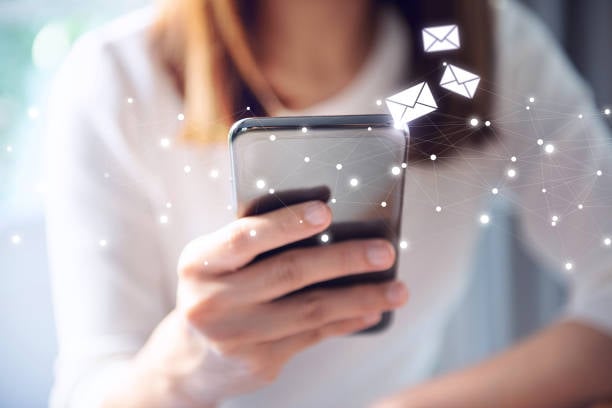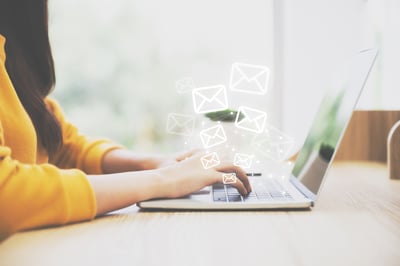January 30, 2023
 by Kasia Slonawska / January 30, 2023
by Kasia Slonawska / January 30, 2023

Have you ever given up on a purchase because you didn’t get a response from the brand?
Being left without an answer is a disappointing experience. It’s one of the reasons customers turn their back on brands and start researching competitive offers. For any business, customer communication and leads are a priority, but time and resources limit what they can do.
What’s the middle ground, then?
Set up autoresponders for repetitive communications and relieve your team of tedious tasks. This is how you can use autoresponders for your marketing communication.
Autoresponders are email programs that work based on simple triggers. A response is sent whenever someone performs a defined action (the trigger).
The simplest example is an out-of-office autoresponder. If you're going on vacation, you can easily set up an email to let anyone trying to reach you know you're not there. In this case, the trigger is every e-mail that ends up in your inbox during the set vacation time.
Autoresponders have plenty of other use cases. You can use autoresponders throughout your marketing communications and seamlessly move leads down the sales funnel.
Let's say someone abandons their shopping cart. You can set up abandoned cart emails to be sent to anyone who adds an item to their cart and abandons it without completing the purchase. You can even personalize these emails, for example, by offering a discount for the item to grab the customer's attention.
Source: Billabong
Another great example is a thank-you email. You can set up automated responses that get sent to everyone who:
The thank-you emails confirm the user’s action (signup, feedback submission, or purchase) has been successful. What’s more, they help build customer relationships. If you want your subscribers and clients to feel special, include a bonus in your thank-you email. It can be a discount code for their next purchase or an exclusive piece of content like an e-book or some templates.
The examples above (vacation autoresponders, abandoned cart emails, and thank-you emails) are individual messages sent each time a trigger activates. Autoresponders come in more extensive forms.
You can set up an entire sequence of automated responses. They work just like single message autoresponders: whenever someone performs a defined action, the first message in the sequence is sent to them. The other messages from the sequence are sent at set periods or according to the user's actions. You can mix these two and prepare multiple sequences for different user paths.
Some examples of automated email sequences include:
If you want to set up a simple autoresponder, for example, an automatic vacation reply, you can do it directly in your email account or client.
Here's how to do it in Gmail.
1. Go to the Settings icon in the upper right corner and select "See all settings
.
Source: Gmail
2. Go to the General tab and scroll to the bottom. This is where you’ll find the vacation autoresponder form.
Source: Gmail
3. Choose when you want your autoresponder to be active and create your desired subject line and message.
To set up an autoresponder for marketing activities, try email management software. It's easy to use, intuitive, and speeds up the process. Just specify the trigger and time for sending your automated response using pre-built templates without coding.
No matter how easy setting up autoresponders may seem, the right strategy and copy are key to success. As with all your marketing campaigns, you need to set a clear goal and communicate clearly to get the desired results. Sometimes automated responses can seem robotic and irrelevant to your audience.
Here's what you need to remember to make your autoresponder worthwhile for your reader.
In other words, adapt the content to the trigger. When someone signs up for your email newsletter, they need confirmation that the signup was successful and a little preview of what to expect: how often you'll send out your newsletter and what the content will be.
Do you have a public library of your past newsletters? Be sure to include the link! You can also use thank-you emails to collect feedback and customize future newsletters.
This is how Ann Handley does it in her thank-you reply.
Source: Copyhackers
Only relevant emails make it to the inbox, so relevancy is key to better email deliverability. Here's a relevancy checklist for any autoresponder message or sequence to send straight to the inbox.
Personalization helps you strike an emotional chord with the recipients. In addition to the recipient's name in the email copy and title, you should also take the time to analyze their language. Start by examining your target audience’s demographics and interests.
Once you have this data, you can discover relevant online communities. For example, look for Facebook groups or YouTube channels and analyze the conversations happening there. Here you can learn more about your audience's specific language and, in general, their habits, views, and preferences. This way, you’ll have tons of data to use in your marketing efforts.
Autoresponders are a big help. They allow marketers to automate various processes that would otherwise take hours of their time or not be possible at all. As good as autoresponders are, you can't overuse them.
With every automated message you send, make sure you provide real value. Address the recipient's current needs, problems, or challenges. Here’s an example of an automated webinar reminder from GetResponse.
Source: GetResponse
The message concerns a webinar the user is subscribed to and was sent shortly before the event started (relevant info – check ✔️). It includes a call-to-action (CTA) button to make it easier for interested people to get to the webinar on time (value – check ✔️) and an alternative link in case they have trouble with the button (address possible challenges – check ✔️).
Simple yet perfect – use autoresponders to serve your audience whenever they need a helping hand (without overly imposing yourself).
Wait, but you’ve just said without overly imposing yourself.
That's right; nurturing interest might sound contradictory to simply serving your audience while there's a specific need. But what if your product or service actually addresses their need? Then you can use autoresponders to pique your lead's interest.
Here's an example. If you have a software-as-a-service (SaaS) product, you can send an automatic upsell message when users reach their subscription limits. They probably won't upgrade right away, but at least they know they can. Fast forward a few months if they keep hitting the limit before their subscription term expires, they finally understand they need an upgraded plan.
Now, over to the fun part: aesthetics. Some email best practices can make your automated response stand out and reach the desired result:
Who said autoresponders couldn’t be fun and engaging?
One of the well-known engaging email elements is quizzes. Some autoresponder software allows you to include quizzes directly in emails. If this option is not available (or it glitches) in your tool, you can include a link to your quiz as a CTA button.
Quizzes will not only encourage engagement but also help you gather valuable data that you can use to your advantage in further communication. Here’s an interesting use case from Alohas, an apparel brand.
They sent an automated message with personalized product offers based on recipients’ previous purchases and visits to product pages. As smart as cookies are when tracking users’ online behavior, they can’t tell the whole truth about a person. This is why Alohas ended up their message with the following prompt:
Source: ALOHAS
Customers not only want marketing communication to be personalized, but they’re also willing to share information to get it. Thanks to the data Alohas gathered in their engagement campaign, they can provide the most relevant product recommendations and personalize their future autoresponders to a great extent.
Some other email engagement tactics include:
It's time to evaluate the success of your autoresponder campaign. Which metrics should you pay attention to?
First, the open rate. A good email open rate should be between 17% and 28%, but it all depends on the type of campaign and niche. There is no standard, and no need to worry if your open rate falls outside this range. Instead, you can constantly challenge yourself and your past results.
To improve your open rate, perform a simple A/B test for the autoresponder title. Examine two options to determine which works better for your open rate. Leave the one that performed better or challenge it with another title idea in another A/B test.
Sometimes, changing the communication channel is a good way to improve the open rate. For some triggers, you can autorespond in an SMS or a popup. Again, you can perform a test and see which channel gets a higher open rate.
Another key metric is the click rate. You should measure it whenever your autoresponder message contains a link. For a better click-through rate (CTR), run some tests with different CTAs or CTA button colors. You can also experiment with button placement within the copy or even tweak the copy itself.
Finally, if the primary goal of your autoresponder campaign is to hear back from your audience (e.g., in case of gathering feedback), pay special attention to the response rate.
Your email content should be compelling enough to engage your audience and get a response. Monitor the response rate regularly and make adjustments to your email messaging accordingly.
If you don't get the response rate you want, take a step back and review your content. Is it interesting or relevant enough? Is it too long or too short? Try to figure out what's causing the lackluster response rate and adjust accordingly.
Autoresponders are like a loop that keeps passing. You only dedicate your time to the work once (except for minor tests and improvements) and can reap the rewards for years. To reap the juiciest fruits of your work, ensure your automated message is relevant, personalized, valuable, engaging, and aesthetically pleasing.
Once you get a hang of better-managing emails, it's time to get more out of your inbox. But how? Learn about the basics of email marketing and build your first list.
Kasia Slonawska is a content specialist and growth hacker in email and social media marketing. She’s worked with tech companies such as NapoelonCat and Mailbird. With broad professional experience and educational background in writing, she's helped create unique, engaging content.
One of the most efficient channels for communication, both inside and outside of an...
 by Alex Souchoroukof
by Alex Souchoroukof
After a successful discussion, what are your post-meeting habits? Do you run off to handle the...
 by Wendy Wang
by Wendy Wang
One of the most efficient channels for communication, both inside and outside of an...
 by Alex Souchoroukof
by Alex Souchoroukof



